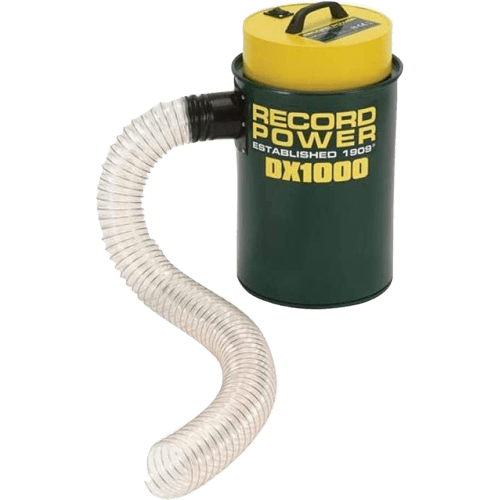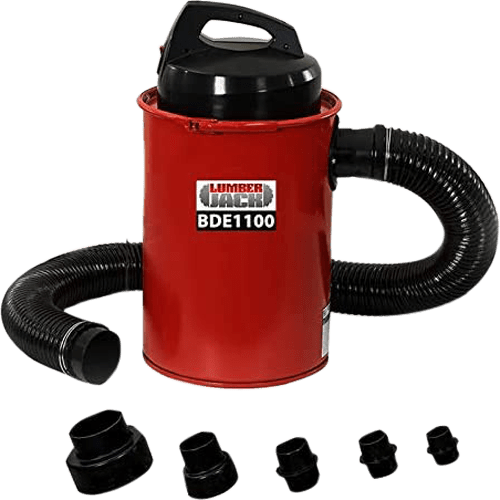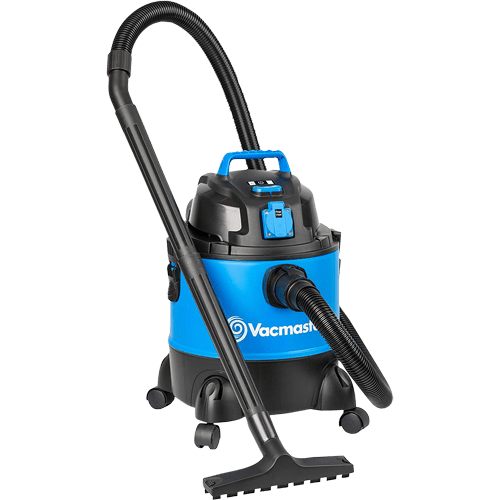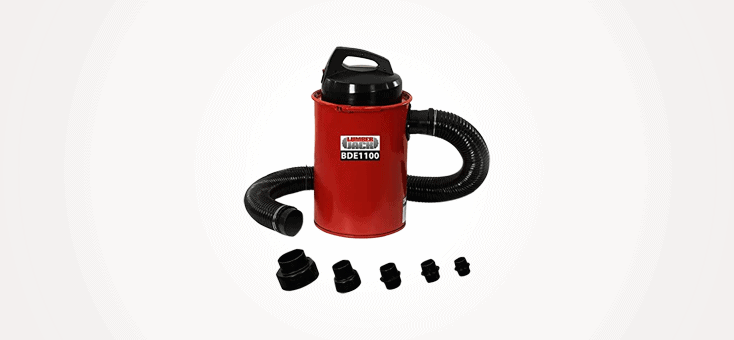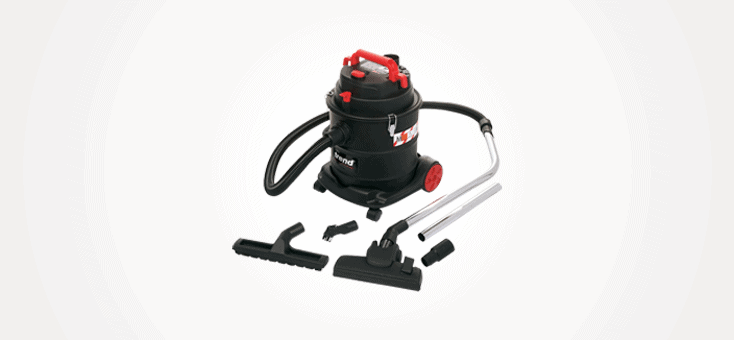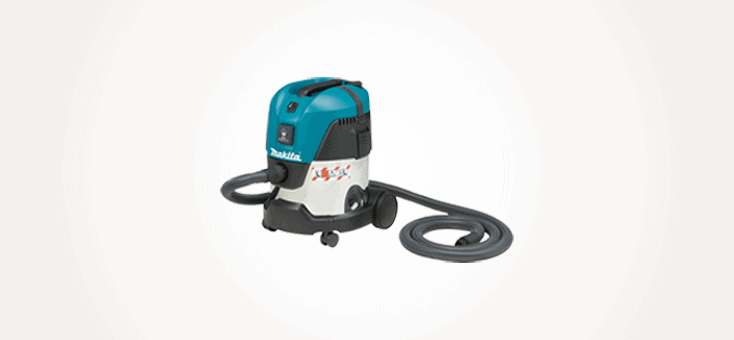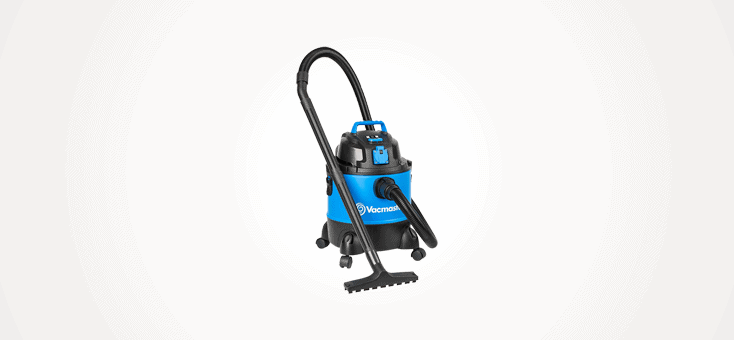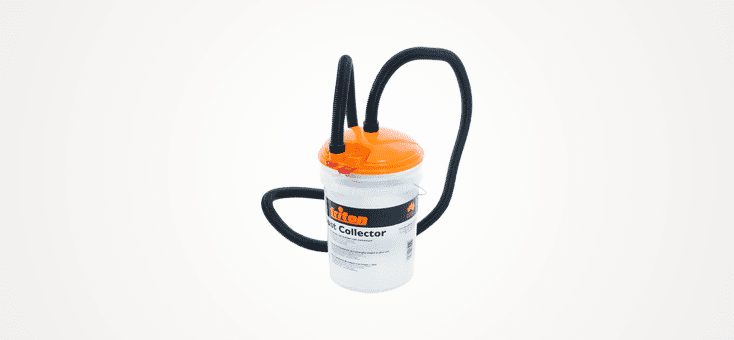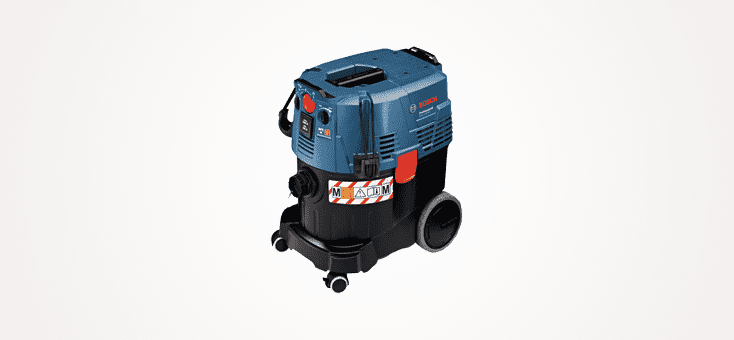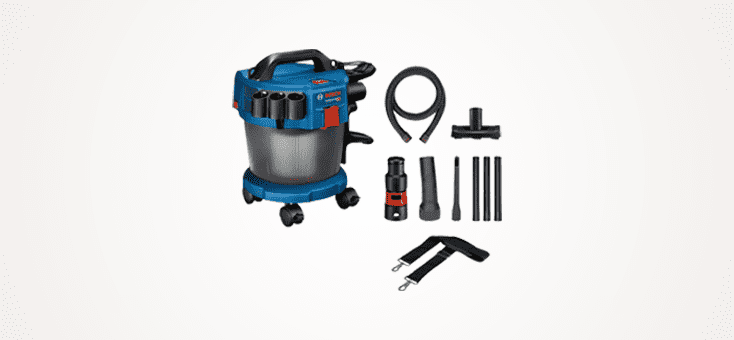10 Best Dust Extractor [Buyer Guide]
We review the products we think are best in the category. By purchasing a product through an affiliate link, we may earn a small commission that helps keep the site running. Learn about our product selection process here.
A dust extractor does exactly what it says on the tin – extracts dust. When working with tools that create large amounts of dust, it is definitely important to invest in a dust extractor. This in turn will leave you with a clear, tidy and mess free workspace that won’t interfere with any of the work that you’re carrying out in your garden. Dust extractors not only remove the annoyance of dust, but also will prolong the lifespan of your machinery. This is because the extractor removes dust and other shavings which would otherwise be sucked into the machine – giving you a clearer line of sight and improving your value for money, too. Work area aside, dust extractors can also prevent potential health risks. Excessive inhalation of dust and other particles can be seriously damaging to your respiratory system. Here at Konservatory, we say save yourself the potential health risk and get yourself a dust extractor! If you’re considering a dust extractor as your newest addition to your garden tools, you may be thinking about how to store it. Well, extractors come in all sorts of shapes and sizes. You can get either workshop extractors or smaller, portable machines. This is great for the gardener who is either an avid tool user wanting a more permanent fixture. The range in size available is also considerate of the gardener who is tight on space. This is however, not the only consideration you’ll have to make before you buy. If you’re in the market to make your own outdoor bar and chairs, or are someone who uses tools often – this buyer guide will help you make the right choice. In this guide we have handpicked 10 of the best dust extractors based on a number of buyer considerations. At the end of this guide, we have also condensed these considerations into a summary section. This summary will allow you to make an informed decision on what’s right for you, your needs and your budget.
Lumberjack Dust Extractor
This 50 litre capacity dust collector is ideally suited for small workshops for dust and wood chippings. It has a powerful 1100w motor built to very high standards and offers effective and high filtration to 0.5 microns. With a quick action, the clamp releases the lid of the drum so you can empty it out with ease. It comes in a pleasant dark red colour and has a 2m length hose which is brill for mobility. It also features an accessory pack, too. Overall, a great extractor that’s on the smaller-side.
Key Features:
1100w motor
Small and compact
High filtration
Carry handle
Specification:
Brand
Lumberjack
Wattage
1100W
Hose length
2m
Container volume
50L
Colour
Red
Accessory pack
Yes
Pros
Great as a worktop dust extractor
Carry handle means it's easy to transport
Huge 50L capacity
Cons
Colour might not be for everyone
Trend Dust Extractor
This dust extractor has an 800w motor – turned on easily with an accessible large top mounted button. Both efficient and safe, this dust extractor features a pleated class M HEPA filter (more on those in our summary below!) which is essential for the effective control of fine dust. With a 20L capacity, this extractor is slightly smaller than the one listed above, but still has a good amount of leeway with how much dust it can gather. It also features a 15.3L capacity microfibre dust collection bag. This dust extractor also comes with an accessory pack which includes: a durable metal cleaning kit created with strength and performance in mind, and a set of cleaning heads for multiple clean-up applications. Coming in a sleek black with pops of red as an accent colour, this dust extractor will look stylish in any garden or garage.
Key Features:
HEPA filter
Dust collection bag
800W motor
Specification:
Brand
Trend
Wattage
800W
Hose length
3m
Container volume
20L
Colour
Black
Accessory pack
Yes
Pros
Includes multiple cleaning heads - great for different jobs!
Looks sleek and non-offensive
Added HEPA filter for fine dust
Cons
Capacity is on the smaller side
Makita Dust Extractor
This dust extractor features a motor head design with flat top and tool deposit section. It gives you the option to enhance the storage solution of the hose it comes with by adding a flexible rubber strap (a great addition if you ask us!). With its washable PET cartridge filter, it is able to protect the turbine by holding back that extra fine dust and debris. This dust extractor’s fleece filter bag allows you to pick up and remove most debris commonly found when undergoing work with wood without any damage to the filter bag. With its push and clean system, it takes only seconds to clean the filter – meaning you’re not faffing around after your work has been done. Leaving you more time to use a cordless leaf blower or soak up the sun with friends and family on your rattan sun loungers! The integrated carry handle is another perfect addition which allows for portability and ease of transportation. Coming in a nice calm blue and white colour scheme, this extractor will compliment any outside space – rather than being an added eyesore.
Key Features:
Integrated carry handle
Washable PET cartridge filter
Fleece filter bag
Push and clean system
Specification:
Brand
Makita
Colour
Blue and white
Accessory pack
No
Pros
Easily cleaned
Portable
Cons
Smaller than some others on the market
Record Power Dust Extractor
This dust extractor is designed to filter down to 0.5 microns, featuring a two stage filtration process for extra fine dust. Ideal for all types of wood dust, even MDF. This extractor minimises the amount of harmful dust in the workshop and is particularly useful for fine dust producers such as saws or sanders. This compact but powerful machine is ideal for workshops with limited space or budget – great to keep in mind if you’re in the market for an extractor that doesn’t take up too much room.
Key Features:
Carry handle
Small and compact
Budget friendly
Specification:
Brand
Record power
Wattage
1200W
Hose length
100mm
Container volume
45L
Colour
Black and yellow
Accessory pack
No
Pros
Lightweight and easy to carry
Cons
Hose length is quite short
Bosch Dust Extractor
This dust extractor features a click and GO interface for easy transportation and handling. It also features a sustained suction power for a longer period of time thanks to its rotational airflow technology. This extractor has a professional 18 V System which provides the ultimate performance with maximum freedom. This essentially means that the battery can be used in other Bosch products as all of their batteries are compatible with new and existing Bosch Professional tools in the same voltage class. This is a real benefit if you’re concerned about budget and cost as this interchangeable battery feature will ultimately save you money in the long run. Please do note though, that you do have to purchase the battery separately.
Key Features:
14kg lightweight construction
Accessory pack included
Specification:
Brand
Bosch
Container volume
10L
Colour
Blue
Accessory pack
Yes
Pros
Easy to carry and move about
Cons
Battery not included
Vacmaster Wet and Dry Vacuum Cleaner Dust Extractor
Key Features:
Wet or dry feature
Foam filter
Optional dust bag
Specification:
Brand
Vacmaster
Wattage
1250W
Hose Length
5m
Container Volume
20L
Colour
Blue
Accessory pack
Yes
Pros
Can be used in multiple different ways
Long hose
Cons
Not exclusively used as a dust extractor so not great for a perm worktop option
Bosch Wet/Dry Dust Extractor
This wet and dry dust extractor with automatic filter cleaning is static-dissipating. This means that any of the equipment supplied with the dust extractor prevents static charging (including the non-marking hose). This dust extractor gives you the option to transport an L-BOXX on the extractor for mobile use – great if you’re needing your dust extractor to be portable and easily transported. It also comes with a tool socket for connecting power tools with automatic on/off switching – including delayed action shutdown for additional convenience. This extractor also comes with an accessory pack too which is always nice. A great all-rounder!
Key Features:
Wet or dry feature
Accessory pack included
Comes with tool socket
Specification:
Brand
Bosch
Wattage
1200W
Hose length
5m
Container volume
35L
Colour
Blue and black
Accessory pack
Yes
Pros
Long hose which is great for mobility
Can use for both wet or dry
Cons
Designed with portability in mind so perhaps not so great for a perm worktop option
Triton Dust Extractor
The use of this dust extractor, as well as any other will prevent sawdust filling up or clogging vacuum cleaners, so it’s great to have a dedicated piece of kit. With its 23L capacity, it’s one of the largest dust extractors on this list! The large container volume will mean you won’t have to constantly keep emptying the dust, saving you both time and effort. This particular extractor is both easy to handle and empty and is compatible with Triton workcentres WCA201, WCA200, WCA001 as well as being compatible with most products with dust extraction outlets.
Key Features:
23L capacity
Small and compact
Specification:
Brand
Triton
Container volume
23L
Colour
Orange and white
Accessory pack
No
Pros
Don't have to empty dust container as often
Cons
No accessory pack included
Bosch Professional Wet/Dry Dust Extractor 110 V
This wet and dry dust extractor with automatic filter cleaning is static-dissipating. This means that any of the equipment supplied with the dust extractor prevents static charging (including the non-marking hose). This dust extractor gives you the option to transport an L-BOXX on the extractor for mobile use – great if you’re needing your dust extractor to be portable and easily transported. It also comes with a tool socket for connecting power tools with automatic on/off switching – including delayed action shutdown for additional convenience. This extractor also comes with an accessory pack too which is always nice. A great all-rounder!
Key Features:
Accessory pack
Can be used wet/dry
Specification:
Brand
Bosch
Wattage
1200W
Hose length
5m
Container volume
35L
Colour
Blue
Accessory pack
Yes
Pros
Super long hose length
Cons
Not a worktop dust extractor
Bosch GAS 18 V-10 L cordless wet/dry extractor
This GAS 18 V-10 L cordless wet/dry extractor by Bosch has excellent suction power over a long period of time thanks to the filter-friendly rotational air flow of the GAS 18 V-10 L. It is also easily transported thanks to its lightweight and compact design. All of Bosch batteries are compatible with new and existing Bosch Professional tools in the same voltage class. Items included: GAS 18 V-10, quality hose: 1.6 m, elbow pipe, 3 x extension tubes, crevice nozzle: 250 mm, floor nozzle, HEPA filter, shoulder strap, four removable rolls, adapter, cardboard box.
Key Features:
Can be used wet/dry
Lightweight and compact
Features other things such as an extension tube, crevice and floor nozzle & HEPA filter
Specification:
Brand
Bosch
Hose length
1.6m
Container volume
10L
Colour
Blue
Accessory pack
Yes
Pros
Accessories included
Easily transported
Cons
Doesn't come with battery
Summary
So, after you’ve read all the reviews above – you’ll see that there are quite a few things that you might want to keep in mind before you take the plunge and buy a dust extractor. Like we mentioned above, a dust extractor is important for any gardener who likes to get involved and hands-on in the garden. If you’re using tools regularly, you’ll want a dust extractor to remove any of the dust that could cause a potential health risk – so that’s really important to bare in mind. if you can see dust then you’re definitely breathing in dust, which can lead to serious respiratory diseases and lung conditions – your health is paramount! Dust extraction allows you to keep your work environment free of dust and harmful shavings, allowing you to work safer and more efficiently too. Whether you’re attempting to make your own garden storage bench, 3-seater garden swing or BBQ shelter, a dust extractor should be one of the first pieces of kit you consider buying first.
Along with the health benefits of using a dust extractor by keeping dust and other nasties out of your lungs, an extractor can also save you both time and money. If you think about it, you won’t be spending the last slog of the day wasted on clearing up mountains of dust and shavings. This means that you’ll be able to clear up a whole lot quicker and are able to cosy up in your DIY conservatory that bit longer. The money-saving aspect comes form the fact you won’t need to replace your power-tools as often, protecting the equipment and increasing its longevity. Dust particles that need to be removed by a dust extractor would usually be sucked-up into the machinery that you’re using to complete your task. These dust particles will clog your tool, and if these particles are removed by an extractor instead, your tool will simply work more efficiently and require much less maintenance. This life-span-increasing prospect also applies to tool accessories, too. Here we’ve listed some buyer considerations that you might wish to make before you make your purchase. We’ve also included an FAQ just below to answer any of your burning questions.
Size
One of the most important things that you should keep in mind before you buy is the actual size of the dust extractor you’re looking into. Like we mentioned in our introduction, there are many different shapes and sizes available for dust extractors. If you think about your needs as a gardener, and look into how much time you actually spend using power tools, you’ll be able to tell which dust extractor suits you. There are many available that range from more permanent workshop extractors to smaller, portable machines that you’ll be able to easily navigate wherever you wish to take them. We recommend choosing a dust extractor based on how much time you actually use your tools, whether you’re frequently thinking “wow, that’s a lot of mess” when clearing up, and on whether you’re thinking about taking the dust extractor to other places. One last thing to consider when choosing the size of your extractor is where you’re going to store it. If your outside space is on the smaller side, you might have to store it in your conservatory – and in that case – you’ll probably want it to be smaller and compact! However, if you’re not pushed for size and have a large shed or garage filled with all sorts of tools – perhaps a dedicated, more permanent fixture of a larger workshop extractor will be the one for you. Whatever your needs are – there is definitely a size for everyone!
Noise
Perhaps something you might’ve overlooked if you bought a dust extractor without reading a buyer guide like this one, but the noise produced by some extractors can be a real annoyance – especially if your garden is on the smaller side or shared often. Fortunately, lots of extractors are now made with low noise abilities, which is a real benefit. There’s nothing worse than an overly loud electrical accessory, and this noise is heightened when there’s multiple tools being used at once. So, we recommend choosing a dust extractor with a low-noise feature. You won’t be sorry!
Easy-clean
I’m sure we can all agree that the worst part of any job is the cleaning up afterwards. You’re probably thinking that you’re buying a dust extractor to minimise the mess of your power tools, but did you think about the mess that the dust extractor collects?! Obviously, all that dust needs to go somewhere – but why make it ten times worse when it comes to cleaning it all up? Here at Konservatory, we recommend going for a dust extractor that is easily cleaned. A lot of the dust extractors that we’ve listed in this guide have an easy-clean option, which is great for the gardener who is short on time (or just really hates cleaning up!). Go for a dust extractor that has something like a “push and clean” system, this means that you’ll be able to clean the tool in seconds – leaving more valuable time for you to get cracking in other areas of your outside space or allowing more time for you to soak up the sun on your hammock.
Ease of transportation
As we’ve mentioned a few times above in this buyer guide, a few different types of extractors are available to purchase. You can go for the larger, more permanent fixtures of a worktop dust extractor, or you can go for something that is far more portable and has been created with transportation in mind. There are a few things to look out for if you’re opting for the latter, like the weight, overall size of the extractor and whether they feature things like a carry handle or expandable features.
-
Weight
First off, lets consider the weight of the dust extractor: if you’re going for something that you’re wanting to carry around with you, or perhaps you’re not too precious about your garden tools and are wanting to lend them out to friends or family, the weight of your new dust extractor will be really important to consider. No one wants to lug around something bulky or heavy, so we recommend going for something that is lightweight and is easily carried as a result. A lightweight dust extractor is also beneficial when you think about its uses, if you’re using an area to work (such as a potting bench or table) you’re going to have to lift your dust extractor up to table-top height. Keeping this in mind, you’re going to want your extractor to be easily lifted and moved – so going for a lightweight option is definitely essential.
-
Size
We’ve touched on the size of your extractor above, but we thought we’d chuck it in again here, too. The size is essential when you’re considering your extractor’s ease of transportation. We suggest definitely going for an extractor that is smaller in size if you’re wanting it to be as portable and practical as possible. The smaller the dust extractor, the easier it is moved and transported. A great thing to note is that even if you’re not too fussed about moving your extractor around, those made to be portable will automatically be smaller and more compact in size. This is great if your workspace is tight on space, so perhaps consider this as an option if you’re worried about everything fitting!
-
Carry handle
Like we’ve mentioned above, if you’re wanting to move your dust extractor around – there will be many made for this particular purpose. Dust extractors that are made with portability in mind will feature things such as an inbuilt carry handle. The integrated carry handle feature makes lifting and tilting of container easy and convenient, as well as improving your ability to transport the extractor with ease. We recommend going for an extractor with a carry handle, even if you’re not planning on moving it around. This is because a carry handle might help you with the emptying of the dust bag and the overall cleaning process. Plus, it’s always better to have one than to not and wish you had!
Container Volume
This consideration section is quite self explanatory. This is because if you’re in the market for an extractor, the first thing that might come to mind is how much dust it can actually collect. Going for a dust extractor with a large container volume is definitely beneficial, it saves you multiple trips to the bin and ultimately allows you to get on with more jobs without constantly having to empty the dust container. We suggest going for a dust extractor with a large container volume for ease of use and efficiency.
FAQ
How to make a dust extractor…
If you find yourself a person who loves DIY and you’ve been wondering this whole time whether you can actually make your own dust extractor, the answer is yes! Making a DIY extractor is both possible and great fun! We’ve included a YouTube video for you here showing you exactly how it is done!
Can I use a vacuum cleaner as a dust extractor?
There’s definitely limits, but a vacuum cleaner will work as a dust extractor to some extent… although we don’t particularly recommend it. A vacuum cleaner will suck up dust, however it’s not the best to constantly use as it’s n0t its intended use. We still recommend getting an extractor specifically designed to suck up dust and other shavings or debris.
How does a vacuum dust extractor work?
A vacuum extractor generates a low volume and high pressure which means that as the vacuum pressure increases, the volume of the air passing through the machine decreases.
Are there different types of dust extractor systems?
The short answer is yes! There are many different types of systems, specifically designed for specific jobs. A list of different extractors include:
- Chip or Large Dust Extractors – These machines are designed for the extraction of chippings or large dusts from a bandsaw, table saw, planer, planer/thicknesser or a spindle moulder.
- Fine Dust Extractors – Fine dust extractors extract, in addition to chippings and sawdust, finer dust from a sanding machine.
- Vacuum Extractors – Vacuum extractors are able to deal with most types of wood waste.
- Power Tool Extractors – Power tool extractors are small, dedicated vacuum extractors. They are specifically designed to deal with fine dust from power tools.
- Air Filters – You might think all the dust has been extracted after a long day of using conventional dust extractors as listed above, but a ray of sunshine that comes across your garden, shed/garage or conservatory space will highlight all the “hidden” dust that stays airborne. To combat this airborne dust, ambient workshop air filters can be left running quietly in the background. These will electrostatically capture these very fine dust particles.
- HEPA Filters – Any activity that leaves a cloud of very fine dust behind will benefit from the use of a HEPA filter. By using a vacuum extractor fitted with a HEPA filter, these very fine dusts can be collected at their source.
Further Reading
If you’re still not convinced by the benefits of using a dust extractor, perhaps you’ll want to read more about the detrimental effects of breathing in dust and how it can negatively affect your lungs and respiratory system. We’ve found a health article here going into depth about how breathing in dust can lead to a multitude of sins. Click here if you’d like to learn more!


